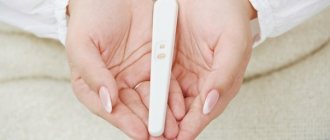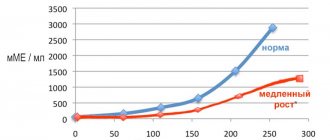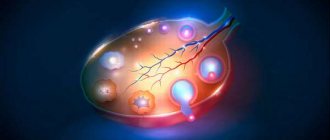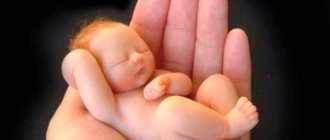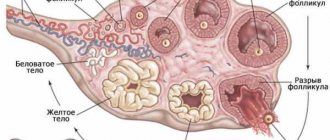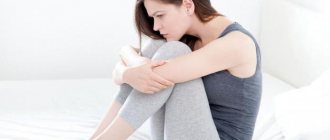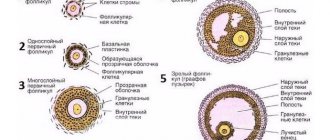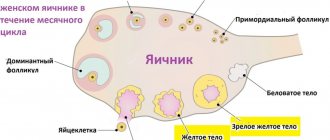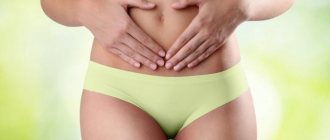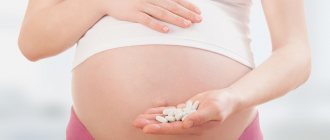To conceive a small miracle in a woman’s body, preparation is required not only moral, but also physical. For the conception process, the follicle must grow to a certain size. If there is a failure in the maturation and growth of follicles, this is where difficulties in conceiving a child begin.
Every month, follicles grow and are renewed in a woman’s body. Afterwards ovulation and conception occurs.
Follicles and their importance for the female body.
A follicle is considered to be a formation in the ovarian cavity of the female body, consisting of an immature egg and protective cells that envelop the outside of the egg. Such formations inside a woman’s body are responsible for very important processes, such as the body’s endocrine processes and reproductive processes.
These formations appear in the body even when the formation of a new organism begins in the womb. At this time, about 1.5 million follicles are stored in the girl’s developing body. During growth and development, they decrease, and by the period of maturation there are about 300 thousand units left.
So how many follicles should there be to conceive a child, and what do they consist of?
The main part of the follicles are oogonia, the so-called germ cell germs. After meiotic division occurs and growth increases, first-order oocytes are formed from them. Further processes occur with the epithelium covering the cells that have not fully developed, and primordial follicles begin to form. Such follicles remain dormant until the onset of puberty in a woman’s body.
Next, a process called folliculogenesis occurs, it is this process that develops follicles to:
- Preantral;
- Antral;
- Preovulatory.
After the complete development of the follicle, ovulation occurs in the woman’s body. And in place of the detached follicle, a gland is formed, which will be temporarily responsible for endocrine function.
There are also cases when the follicle does not perform its function. That is, ovulation does not occur. And this is very dangerous for a woman’s body; such a follicle gradually grows in size and becomes a follicular cyst. In the formation of such a cyst there are germ cells containing a large supply of nutrients. There are cases of self-elimination of such neoplasms. But in the worst cases, the cyst will remain in the woman’s body for a long time and the shape of the genital organs will begin to change. This also affects a woman’s conception of a child, not for the better.
Beginning of growth of follicular cell organisms.
The size of the follicle changes almost every day during its development. The onset of changes begins during the onset of the menstrual cycle. Every month, several follicles grow and mature in a woman’s body. Let's look at the growth and size of the follicle by day of the cycle. And also at what size of the follicle ovulation occurs.
- From the beginning of development until the 4th day of the beginning of the cycle, it is possible to see a certain number of antral follicular bodies. Their size is usually no more than 4 mm in diameter. These follicles can be located in both the right and left ovaries, or both at the same time. The number of growing follicles directly depends on the number of eggs in the reproductive system, as well as on the age of the woman herself. A good indicator, not exceeding the norm, is considered to be 9 antral follicles, simultaneously developing and maturing in both ovaries.
- Starting from the 5th day of development of the antral follicle, its size increases to 6 mm on average. They develop evenly in comparison with each other, this helps to understand the ultrasound examination. But at this stage, perhaps the beginning of follicular atresia. This condition of the follicles stops their maturation and reverses the process. But, as a rule, this does not happen with all follicles, and some continue to develop further.
- The seventh day is probably the most important day in the development of the follicle. On this day, the dominant follicle is determined, its size increases by day of the cycle every day. The size of such a follicle is about 9-10 mm. Such a follicle begins its most active development. And the remaining follicles will begin to disappear, but not all may disappear, but may be present during ovulation.
- During the 8th day of the follicle development cycle, its size usually already reaches about 12 mm.
- On the 9th day of follicle growth, a cavity forms inside the vesicle. It is commonly called the follicular cavity. The size of such a follicle is about 14 mm.
- On day 10, the size of the dominant follicle increases to 16 mm, but the remaining follicles continue to develop in the opposite direction and gradually disappear.
- During the 11th day of the development cycle, follicle growth reaches 18mm.
- On the 12th day, thanks to the formed cavity inside the follicle, its size increases to 20 mm.
- On day 13, we can already say that the follicle is ready for ovulation. Its size is about 22 mm. This value is the minimum for productive ovulation. A so-called stigma appears on one of the walls of the follicle. Subsequently, the egg will be released through it when the follicle ruptures.
- On the 14th day of the follicle development cycle, the process of ovulation occurs. The follicle is approximately 24 mm in size when the ovum begins to rupture and is released. The size of the egg at ovulation is about 2.5 cm.
If an ultrasound examination reveals deviations from the norm in the growth of the follicle in a smaller direction, it is considered to be extremely unfavorable. There are cases that ovulation begins earlier than on the 14th day of follicle growth. This is also determined by the physical condition of the female body. Such ovulation may occur ahead of time on days 8 and 12.
Determination of follicle growth.
Folliculometry is used to accurately determine the growth and correct development of follicles. Such a study is carried out using an ultrasound machine. During this procedure, control over the development of follicles becomes possible. It is impossible to do without such a procedure in cases where conception naturally is not possible, or there are problems during the menstrual cycle.
How can folliculometry help?
Demonstrates how the follicle grows by day of the cycle.
- Determines the onset of ovulation accurate to a specific date.
- Will show the exact size of the follicle at ovulation.
- Determine the performance of the ovaries.
- Plan the gender of the child.
- To see whether a woman’s menstrual cycle is proceeding correctly.
- Find out the best day to fertilize an egg.
- Monitor the dynamics of development of multiple pregnancies.
- Track a woman's hormonal background.
Generative function as a priority
On the inside, the mature follicle is lined with multilayered epithelium; it is in it (in the thickened area - the oviductal tubercle) that a mature egg capable of fertilization is located. As mentioned above, the normal follicle size is 18-24 mm. At the very beginning of the menstrual cycle, a protrusion (resembling a tubercle) on the surface of the ovary is observed.
Further, the walls of the follicle become significantly thinner, which leads to its rupture. Thus, in place of the Graafian vesicle, a corpus luteum appears - an important endocrine gland.
Due to a number of hormonal disorders, this gap may be absent, and therefore the egg does not leave the ovary and the process of ovulation does not occur. It is this moment that can become the main cause of infertility and dysfunctional uterine bleeding.
Norms and pathologies in the development of follicles.
If tracking follicle maturation is required, more than one ultrasound examination will be required. Every stage of development is important here, because pathology can disrupt all plans.
There are such types of pathological interference in the development of follicles as:
- Atresia is generally considered to be a pathology that can freeze follicles at a certain stage of development and reverse their growth. Which will lead to their disappearance, and ovulation in such follicles will never be able to occur.
- Persistence is a manifestation of infection in a woman’s body. This pathology does not have a detrimental effect on the development of the follicle, but rather on the fact that the mature follicle does not rupture. As a result, the release of luteinizing hormone into the body does not occur.
- A follicular cyst is a peculiar formation that is visualized in the ovarian tissues. With this pathology, the follicle that has not undergone ovulation does not come off, but remains in place and fluid accumulates inside its cavity. Which leads to the growth of a formation called a cyst. The size of such a neoplasm can be more than 3 cm.
- Luteinization - with this pathology, the formation of the corpus luteum occurs without waiting for the follicle to rupture. A pathology of this kind can occur in cases where the ovaries have been damaged.
Stimulation of follicle growth and ovulation.
Such procedures are carried out in cases where pregnancy does not occur naturally. But there are also indications for the procedure and contraindications.
The stimulation procedure is carried out:
- For irregular menstrual cycles.
- Or for unexplained reasons for the lack of conception.
Stimulation is not performed in cases where:
- There is poor patency of the fallopian tubes.
- For a number of reasons, diagnosing the possibility of stimulation cannot be carried out.
- Infertility in men.
- Lack of follicular reserve.
Stimulation is also not prescribed for those who have been treating a problem such as infertility for more than two years.
Lack of follicular development
Insufficiency of follicular development at certain stages can be detected in the following cases:
- "dormant ovary" syndrome;
- defects in follicular development (it occurs only up to a certain size, and then stops and regression occurs).
Such violations may be caused by:
- a certain age of a woman: after 37-38 years, the ovarian reserve is practically depleted, so the lack of growth may be due to the absence of the follicular elements themselves;
- pre-ovarian wasting syndrome;
- chronic pathologies of the reproductive organs;
- surgeries on the organs of the reproductive system;
- exposure to toxic substances on the body;
- chronic stress.
So the lack of a sufficient number of follicles and/or the lack of their enlargement may be to blame for a host of both exogenous and endogenous disorders. Therefore, before the stimulation procedure, it is necessary to undergo a thorough examination in order to eliminate possible obstacles to ovulation as much as possible.
Why doesn't the follicle grow or rupture?
The menstrual cycle consists of several stages. One of them is ovulation. During this period, a mature and fertilizing egg should ideally emerge from the follicle, which has matured for a month. Then, as a result of a rupture, it enters the peritoneal cavity.
The time interval between follicle maturation and ovulation is on average two days. Once the egg is released from the ovary, it begins to travel through the fallopian tubes to the uterus. If ovulation does not occur on the first day, the egg dies. But it happens that the follicle does not mature. In this case, ovulation cannot occur.
There are many reasons for the lack of ovulation. Often, problems with conception are caused by:
- dysfunction of the ovaries and parts of the brain, which are responsible for the production of hormones necessary for the maturation of the follicle and egg;
- inflammatory processes in the pelvic organs;
- disruptions in the functioning of the adrenal glands and thyroid glands;
- neoplasms of the hypothalamus and pituitary gland;
- frequent stressful situations;
- depressive disorders;
- neoplasms, in particular follicular cysts;
- genetic predisposition;
- adhesive process, including paraovarian adhesions;
- persistent follicle (follicle does not rupture);
- the presence of bad habits.
Treatment of the disease should be carried out by an experienced specialist and only after all the necessary studies, including ultrasound. Along with traditional methods of stimulating the growth and enlargement of follicles, it is recommended to use folk remedies to treat follicles.
How to enlarge follicles in the ovaries with folk remedies
Along with taking medications, you can use herbal remedies. They help stimulate growth and enlarge follicles.
The use of herbs and special diets to solve problems with conception, as well as for its onset, has been known since ancient times. The main active component of such drugs is phytohormones, which have an effect on the woman’s body similar to conventional hormones.
Follicle growth with the help of folk remedies, as well as maturation and subsequent rupture, occurs somewhat slower compared to therapies with traditional methods. On average, complete restoration of ovulation occurs after three months of using unconventional methods.
Correct and appropriate treatment of the disease at home using traditional medicine and diet contributes to:
- stimulating the growth of endometrioid tissue;
- improving the physiological state of the ovaries;
- timely maturation and rupture of the follicle.
It is important to understand that it is impossible to grow a follicle using folk remedies without following a diet.
Hormonal diet
There are foods whose regular consumption helps normalize reproductive function. For women facing this problem, it is recommended to introduce into the diet: legumes, pumpkin, flax, sesame seeds, apples, cucumbers, tomatoes, beets, dates, pomegranate.
It is also important to know products that inhibit estrogen production. Experts advise avoiding the consumption of citrus fruits, cabbage, wheat flour, melon, pineapple, rice, pears, and figs.
Smoking, drinking alcoholic beverages, coffee, strong tea, sweet soda and processed foods must be completely abandoned.
Stimulation agents proven over centuries
If the follicles do not mature, treatment with folk remedies will help with this. The main thing is to use preparations from medicinal plants advisably and only with the permission of a doctor.
Traditional medicine has many effective compounds that help stimulate the growth and enlargement of follicles, their maturation and subsequent rupture. They are effective and will help in the fight against the disease. The main thing is to use them wisely, adhering to dosages and proportions.
- If the follicle does not burst, folk remedies will come to the rescue. Sage is very useful for the maturation and further rupture of the follicle. The plant contains estrogens, identical in structure to the hormones produced by the female body. To prepare the infusion, you will need 30 grams of dried leaves of the plant. Brew the crushed raw materials in 200 ml of boiling water. Leave it to sit for half an hour. Drink ¼ glass of strained drink four times a day. It is preferable to start the therapeutic course on the fifth day of the cycle.
- Use of healing infusion. This is a very effective folk remedy for persistent follicles. If the follicle does not rupture, use linden and sage. Mix sage leaves with linden inflorescences in equal proportions. Steam the raw materials - two spoons with boiling water - 300 ml. Leave the composition to brew. It is recommended to consume 30 ml of filtered drug three times a day.
- Plantain helps stimulate ovulation. If the follicles do not mature or persistence of the left ovary is detected, treatment of the disease with folk remedies can be very effective. It is recommended to use plantain decoction. To prepare it, take 30 grams of plantain seeds. Steam the raw materials with boiled water. Place on the stove and wait until it boils, and then leave to simmer for five minutes. Cool the composition and take 30 ml of the drug three times a day.
- Rose in the fight against diseases of the reproductive system. For those who do not know how to help burst a follicle using folk remedies, the following decoction is presented. To prepare a rose decoction, pour thirty grams of fresh petals with boiled water - 400 ml. Boil the mixture for ten minutes. Next, leave the product to sit. It is recommended to take the medicine at night, one tablespoon at a time.
- Persistent ovarian follicle, treatment with folk remedies: the use of aloe vera. To achieve the maximum therapeutic effect, it is recommended to use leaves of a plant that is more than five years old to prepare the medicine. Take a few leaves, wash them and place them in the refrigerator for five days. Next, grind the raw materials and mix in equal proportions with honey, ghee and lard. You need to take 20 grams of the prepared mixture twice a day.
- Uterus boron will help in the treatment of ailments of the reproductive system. This plant is one of the most effective for infertility. It will also help in stimulating the growth, maturation and rupture of the follicle. Steam 50 grams of dried herb with boiling water - 0.5 liters. The composition should be infused for ten hours. Filter the product and drink ½ glass of the drink three times a day.
- Essential oils will help normalize the functioning of the reproductive system. To stimulate the maturation of follicles, it is recommended to take baths with the addition of essential oils (anise, sage, lavender, basil or geranium).
- Laminaria for women's health. Fill a gauze bag with kelp and place it in a glass. When the raw material swells, lower it into a bath filled with hot water. The duration of the procedure is 15 minutes.
- Herbal mixture to enlarge follicles. Mix rowan fruits with chamomile, motherwort, viburnum bark and Rhodiola rosea rhizomes in equal proportions. Steam the raw material with boiling water - 400 ml and put it in a warm place for ten hours. Drink ½ cup of strained medicine twice a day.
Folk remedies for follicle rupture, as well as its maturation, presented above, are effective and will help improve the functioning of the reproductive system. However, the maximum therapeutic effect can be achieved only if the medicinal compositions are used appropriately.
If you are going to stimulate follicle growth with folk remedies, before using this or that medicine, be sure to consult a qualified specialist regarding its usefulness in your case. In addition, for the product to be beneficial, stick to the dosage and proportions.
Where do twins come from?
The “main” follicle is determined approximately on days 7-10 of the cycle. All others shrink and die naturally. But sometimes it happens that there are two “leaders” at once. In a natural cycle (that is, without the use of hormones to stimulate ovulation), this happens quite rarely - in one woman out of ten, and not every monthly cycle.
It happens that two dominant follicles in different ovaries (or in one - this is also possible) ovulate, that is, burst. And then there is a chance that both eggs will be fertilized. This means that fraternal twins will be born.
Unlike twins (when one egg is fertilized by two sperm), twins are not identical, not identical. They can be of different sexes or the same sex, and look alike, like ordinary brothers and sisters.
So, the correct growth of the dominant follicle and subsequent ovulation are clear signs of women’s health. And possible violations should alert you (and your doctor), but not frighten them. Indeed, in most cases such deviations are successfully treated.
The female body is much more complex than it might seem at first glance. Many processes in it are controlled exclusively by hormones, and how well coordinated they are depends, for example, on whether a woman can conceive and bear a child, and how long her reproductive health will be maintained. One of these complex invisible processes is the formation of a dominant follicle in the ovaries.
For what diagnoses is follicle stimulation performed?
Today, stimulation of ovarian function is one of the fundamental methods in the treatment of infertility.
Stimulation is recommended in the following cases:
- Anovulatory infertility associated with ovarian dysfunction (problems with follicle development and ovulation - hormonal dysfunction, polycystic disease).
- Infertility of unknown origin.
- Stimulation of “superovulation” in the IVF protocol.
The main task of the doctor when stimulating ovarian function is to ensure the growth of one or many follicles to a preovulatory state, with the obligatory introduction of a trigger (a drug that imitates the peak of luteinizing hormone) of ovulation at the final stage of folliculogenesis.
Stimulation is a serious intervention in the functioning of the female body, so the doctor initially assesses its need.
To do this, before the procedure, the patient and her partner will need to undergo a comprehensive medical examination, undergo a series of tests and exclude conditions that are contraindications for stimulation:
- Contraindications to pregnancy.
- Pregnancy or lactation period.
- Uterine bleeding of unknown etiology.
- Inability to monitor follicle growth using ultrasound.
- Infertility has been treated for more than 2 years.
Causes of anovulation
Should ovulation occur with every menstrual cycle? It turns out not! Normally, a woman goes through several cycles a year without ovulation - the reproductive system takes a kind of “vacation” for itself. The older a woman is, the more often her ovaries strive to rest, so the chances of rapid conception decrease after 35-40 years.
Among the pathological causes of ovulation, disturbances in the functioning of the endocrine system, inflammatory diseases, structural features of organs and stressful conditions come first.
Expert commentary
First of all, the reason for the lack of ovulation is changes in hormonal levels. It could be:
- dysfunction of the thyroid gland;
- dysfunction of the pituitary gland;
- improper production of prolactin levels, which leads to an imbalance of the hormones FSH and LH.
In addition, ovulation may be absent due to inflammatory processes in the body.
What and how to stimulate follicle growth: drugs and techniques
Conditions for stimulating follicle growth:
- Confirmed patency of the fallopian tubes.
- Satisfactory spermogram indicators.
- Prolactin levels are normal.
Stimulation schemes
With the normal functioning of a woman’s reproductive system, almost every menstrual cycle, one egg matures.
On average, about ten follicles begin to mature in the ovary - and only one grows before the dominant follicle, in which the egg matures.
In order for several dominant follicles to mature in the ovaries at once, they are stimulated through hormonal therapy.
Depending on the further actions - natural conception, intrauterine insemination, or puncture of oogonia in order to obtain oocytes and their further fertilization in vitro ("in vitro") - the type of hormonal stimulation is selected.
Video: Follicle puncture
1 type of follicle stimulation
It is carried out with drugs (clostilbegit, Clomid) that enhance the production of hormones in the pituitary gland and hypothalamus, which leads to stimulation of the growth and maturation of follicles.
The stimulation process lasts 5 days, starting from the 2-5th day of the menstrual cycle.
Folliculometry is mandatory - the doctor monitors the growth of the dominant follicle and assesses the state of the endometrium, then the drug HCG (pregnyl) is administered for planned ovulation.
Next, the patient takes progesterone drugs (Duphaston, Utrozhestan, Kraynon Gel), which ensure the normal functioning of the corpus luteum.
If after stimulation in the first cycle the dominant follicle is absent, then in the second the dosage is increased.
Often, drugs of this type are ineffective in patients with high blood pressure or who are overweight.
In case of a weak ovarian response to stimulation, with low sensitivity to the drug, it is recommended to stimulate ovarian function with gonadotropins (hormones responsible for the regulation of the sex glands).
Type 2 follicle stimulation
Gonadotropins (puregone, menogon, gonal) are prescribed. The natural development of follicles is simulated - therefore, to correctly select the dosage of drugs, it is necessary to perform an ultrasound on certain days of the cycle.
Stimulation begins on days 2-3 of the cycle. Provided that the follicles grow normally, by the middle of the menstrual cycle the patient is prescribed the drug HCG (pregnyl) for planned ovulation.
After this, to maintain the effective functioning of the corpus luteum, progesterone preparations are taken.
Type 3 follicle stimulation
Simultaneous use of clostilbegit and gonadotropins at different stages of follicle growth.
Stimulation begins on days 2-5 of the cycle. Clostilbegit is used for the first 5 days, then gonadotropins are taken for 5-7 days.
When the follicle reaches the desired size, in order for ovulation to occur, a hCG drug (for example, pregnyl) is administered, and from the 16th day of the cycle, progesterone drugs are used.
Why are they empty?
Empty follicle syndrome (EFS) means that none of the mature follicular formations have formed an egg.
Most often, this situation is a consequence of a diagnostic error. To establish that this is indeed SPF, the following conditions must be excluded:
- early ovarian failure;
- early ovulation;
- weak response to stimulation;
- incorrectly selected dose of hormones in the current IVF protocol;
- insufficiency of absorption of human chorionic gonadotropin by the woman’s body;
- disturbances in the formation of the egg;
- similar problems in a regular cycle (without induction).
ATTENTION! If all these reasons are excluded, there still remains the possibility that the biomaterial was selected incorrectly, or the diagnostic technology was violated.
And the reasons for the SPF itself can be:
- polycystic disease;
- endometriosis;
- obesity;
- depletion of ovarian reserve;
- chromosomal diseases;
- adhesions in the fallopian tubes;
- chronic stress.
In addition to these reasons, a violation of the IVF technology itself cannot be ruled out.
Features of follicle stimulation during IVF
During the IVF procedure, for higher results, due to stimulation of ovarian function, several dominant follicles must mature at once.
During ovarian puncture, eggs are removed and then fertilized in the laboratory.
If the procedure is successful and a high-quality embryo is formed, it is “planted” into the mother’s body - where, if implantation is successful, it continues its development. The day of implantation is determined by the doctor based on the results of folliculometry.
Then the pregnancy proceeds as usual. The probability of conception varies from 20 to 30%.
All manipulations are carried out under the strict supervision of a doctor!
Unfortunately, today the problem of infertility is very acute for many couples. However, over time, it becomes possible to select adequate therapy, depending on the state of reproductive health of the partners and their age.
The main tasks of a doctor dealing with infertility are not to miss the important things - and not to do anything unnecessary.
Share with your friends:
Medicinal methods of stimulating ovulation
THERE ARE CONTRAINDICATIONS SPECIALIST CONSULTATION REQUIRED
Antiestrogenic drugs (Clostilbegit, Serofen, Clomid). These drugs in tablet form are the most frequently prescribed today; they are the most affordable among ovulation-stimulating drugs. The main effect of these drugs is to increase the levels of FSH and LH. However, the prescription of anti-estrogenic drugs should be approached with great caution: the slightest violation of the dosage can lead to hyperstimulation, which threatens polycystic ovaries, their depletion and early menopause. In addition, it is recommended to conduct no more than six courses of such therapy in a lifetime. This means that the use of these drugs must be carried out under the very strict supervision of a doctor.
A milder treatment regimen for the ovaries is considered to be treatment with injections based on human menopausal gonadotropin (for example, Menogon, Pergonal, Menopur). These drugs are synthesized from the urine of menopausal women. They contain the hormones LH and FSH, which are responsible for regulating the menstrual cycle and maturation of follicles (and therefore help trigger ovulation).
Home methods to stimulate ovulation
THERE ARE CONTRAINDICATIONS SPECIALIST CONSULTATION REQUIRED
Herbs
It is known that many plants contain phytohormones - substances whose effects are similar to human hormones. It is these properties of plants that many use in home practice. We have collected several herbs to stimulate ovulation, which are most often heard in the recommendations of “experienced” people.
Sage (decoction). Sage contains phytoestrogen, a plant-derived substance similar to human estrogen. It is believed that sage decoction promotes the formation and growth of follicles, so it is recommended to take it in the first phase of the cycle.
Attention! Sage has many contraindications: it is dangerous for polycystic ovary syndrome, fibroids, endometriosis, pregnancy, and lactation.
Linden blossom (decoction). Linden flowers also contain phytoestrogens, so if there are no contraindications, linden tea can also be drunk in the first half of the cycle. Unlike sage infusion, which is noticeably astringent, it is also delicious!
Red brush (decoction). This plant is known as “the most feminine plant”; it is believed that a decoction from it can help restore the balance of estrogen and progesterone - hormones that play an important role in the maturation of follicles, the release of the egg and the further development of pregnancy.
Rose petals (decoction). This is perhaps the most romantic and mysterious way to bring ovulation closer! 1 tbsp. l. rose petals (it is better, of course, to take it from your own garden, rather than buy it in a store) you need to pour a glass of boiling water and leave in a water bath for 15 minutes. Ready! Take 1 teaspoon before bed in the first half of the cycle. The “magical” properties of this decoction are explained by its high vitamin E content.
Do not self-medicate - be sure to consult with your doctor whether you can take this or that decoction - almost all herbs have contraindications.
Spa treatments
Healing mud. Healing mud wraps are a well-known sanatorium method of healing. Therapeutic mud enhances hormonal activity, helps eliminate inflammatory processes and helps restore reproductive functions. Such wraps and mud applications can be done independently at home - after consultation with your doctor, of course.
Baths with kelp. Another pleasant home method, which is very often recommended, without, however, explaining the subtleties of the mechanism of its effect, is stimulating baths with kelp. You can buy dry kelp at a pharmacy, steam it thoroughly and add the resulting infusion to the bath. Among other things, kelp is also an excellent anti-cellulite remedy - so the benefits are guaranteed!
Diet
To normalize hormonal levels, all means (especially those approved by the doctor) are good! For example, a diet that includes foods that stimulate the production of estrogen. It is worth paying attention to:
- pineapples;
- soybeans and legumes;
- grenades;
- carrot;
- pumpkin and sesame seeds;
- full fat milk;
- spinach;
- sprouted wheat.
Vitamins
We wrote about the undoubted benefits of vitamins during pregnancy planning in a recent review. Taking vitamins such as folic acid, E and C actually increases the chances of successful conception. But it is unlikely that vitamins will help trigger ovulation in case of serious pathological disorders.
Expert commentary
The use of “home remedies” is not prohibited. Each of the above can be applied. But in itself this will not bring much effect. Therefore, you should not self-medicate - it will simply take time, and when treating infertility, time is a very important factor. If problems arise, it is better to immediately contact specialists. The doctor will conduct a diagnosis and, if necessary, select medications to stimulate ovulation. You can drink decoctions, juices or, for example, take vitamins in parallel with the treatment prescribed by the doctor.
Important information? Share it on social networks, someone will definitely find it useful!
